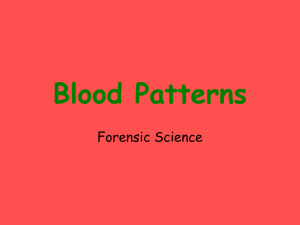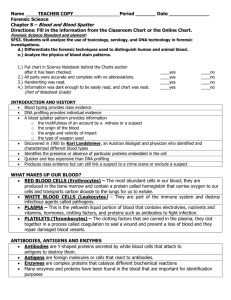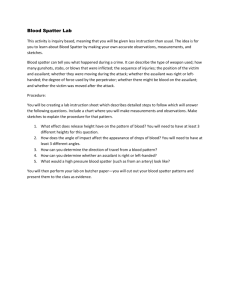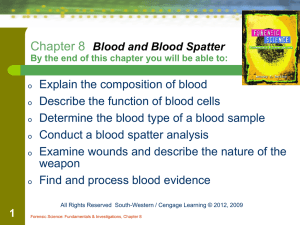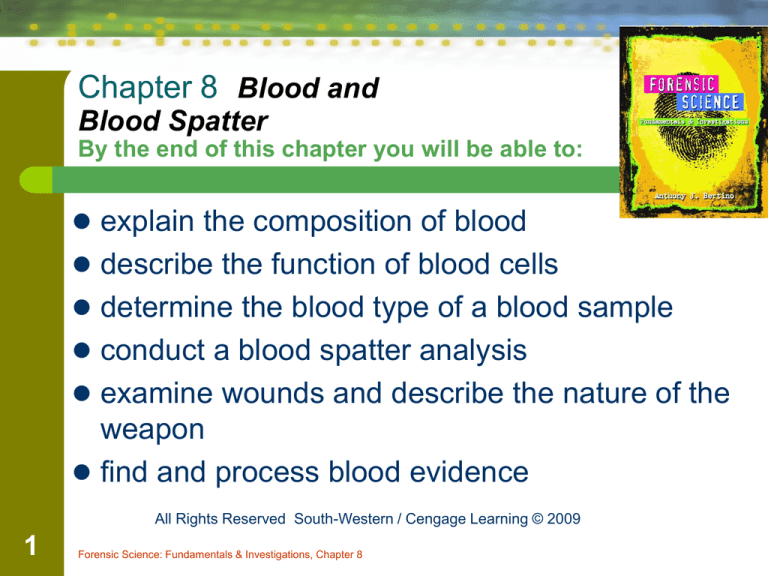
Chapter 8 Blood and
Blood Spatter
By the end of this chapter you will be able to:
explain the composition of blood
describe the function of blood cells
determine the blood type of a blood sample
conduct a blood spatter analysis
examine wounds and describe the nature of the
weapon
find and process blood evidence
All Rights Reserved South-Western / Cengage Learning © 2009
1
Forensic Science: Fundamentals & Investigations, Chapter 8
Introduction and History
2
Blood typing can provide class evidence;
whereas DNA profiling can provide individual
evidence.
A blood spatter pattern can give information
about the truthfulness of an account by a
witness or a suspect.
It also can provide information about the origin of
the blood, the angle and velocity of impact, and
type of weapon used.
Our understanding of blood began in ancient
times and continues to grow today.
Forensic Science: Fundamentals & Investigations, Chapter 8
Composition of Blood
Whole blood carries cells and plasma—the fluid
3
with hormones, clotting factors, and nutrients.
Shown above respectively:
Red blood cells carry oxygen to the body’s cells
and carbon dioxide away.
White blood cells fight disease and foreign
invaders and, alone, contain cell nuclei.
Platelets aid in blood clotting and the repair of
damaged blood vessels.
Forensic Science: Fundamentals & Investigations, Chapter 8
Blood Typing—Proteins
42%
12%
3%
of the population in the United States
(of which 85% is Rh+)
43%
Blood typing is quicker and less expensive than
DNA profiling.
It produces class evidence but can still link a
suspect to a crime scene or exclude a suspect.
4
Forensic Science: Fundamentals & Investigations, Chapter 8
Blood Typing—Antibodies; Additional
Proteins and Enzymes
Antibodies are proteins secreted by white
blood cells that attach to antigens to destroy
them.
Antigens are foreign molecules or cells that
react to antibodies.
Enzymes are complex proteins that catalyze
different biochemical reactions.
Many enzymes and proteins have been found in
the blood that are important for identification
purposes.
5
Forensic Science: Fundamentals & Investigations, Chapter 8
Blood Typing—Probability and
Blood Types
Given the frequency of different genes within a
population, it is possible to determine the
probability that a particular blood type will appear
in a particular population.
To determine the probability of two separate
events, it is necessary to multiply their individual
probabilities.
By identifying the additional proteins in the blood
evidence sample, investigators can limit the size of
a suspect population and help identify a suspect.
6
Forensic Science: Fundamentals & Investigations, Chapter 8
Blood spatter
7
In 1939 the meaning of the spatter pattern was
first analyzed.
When a wound is inflicted, a blood spatter
pattern may be created.
It takes a grouping of blood stains to make a
blood spatter pattern.
The pattern can help to reconstruct the events
surrounding a shooting, stabbing, or beating.
Forensic Science: Fundamentals & Investigations, Chapter 8
Blood spatter Analysis
Analysis of a spatter pattern can aid in determining
the:
– direction blood traveled.
– angle of impact.
– point of origin of the blood.
– velocity of the blood.
– manner of death.
8
Forensic Science: Fundamentals & Investigations, Chapter 8
Blood spatter
Analysis
When blood falls from a height or at a high
velocity, it can overcome its natural
cohesiveness and form satellite droplets.
When it falls onto a less-than-smooth
surface, it can form spiking patterns around
the drops.
9
Forensic Science: Fundamentals & Investigations, Chapter 8
Blood spatter Analysis—Six
Patterns
Describe each of these:
a. passive drops
b. arterial gushes
c. splashes
d. smears
e. trails
f. pools
10
Forensic Science: Fundamentals & Investigations, Chapter 8
Typical Bloodstain Patterns
11
Vertical drops - 90 deg. to ground
Running drips - all diff. sizes, spines point in
direction of mvt.
Multiple drips - blood letting
Large volume - a lot of blood comes out at
once
Wipe - something moves where blood was
Swipe - blood on object and object moves
Forensic Science: Fundamentals & Investigations, Chapter 8
continued
12
Transfer - walk in blood, transfer it
Arterial spurts - breach of major artery
Cast off Void - area with no blood
Expiratory stains - coughed up blood
Impact spatter from gs, <1mm in size
Impact spatter due to blunt force, 1-4 mm
Forensic Science: Fundamentals & Investigations, Chapter 8
Blood spatter Analysis—Impact
Patterns can help investigators determine the
type of weapon used.
13
–
What kind of a pattern is produced by a gun
shot?
–
What kind of a pattern is produced by a
hammer blow?
Forensic Science: Fundamentals & Investigations, Chapter 8
Blood spatter Analysis—
Directionality
The shape of an individual drop of blood
provides clues to the direction from where
the blood originated.
How will the point of impact compare
with the rest of a blood pattern?
14
Forensic Science: Fundamentals & Investigations, Chapter 8
Blood spatter
Analysis—Location of the Origin of the
Blood
15
Lines of convergence
Draw straight lines down the axis of the
blood spatters.
Where the lines converge, the blood
originated.
Forensic Science: Fundamentals & Investigations, Chapter 8
Crime Scene Investigation
of Blood
Search for blood evidence.
2. If any is discovered, process it determining:
a. Whether the evidence is blood.
b. Whether the blood is human.
c. The blood type.
3. Interpret the findings:
a. See if the blood type matches a suspect.
b. If it does not, exclude that suspect.
c. If it does, decide if DNA profiling is needed.
1.
16
Forensic Science: Fundamentals & Investigations, Chapter 8
. . . . . . . . . . . . . . . . . Summary
Blood consists of cellular components and plasma.
The various human blood types are caused by the
presence or absence of A or B or both A and B
proteins on the surface of red blood cells.
Blood spatter evidence can be used to recreate a
crime scene.
Investigators endeavor to (a) locate, (b) identify,
and (c) interpret blood spatter patterns at crime
scenes.
17
Forensic Science: Fundamentals & Investigations, Chapter 8


